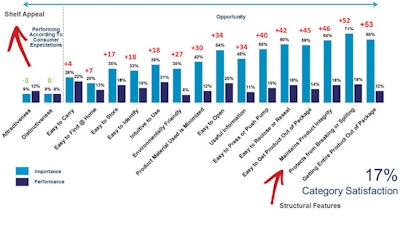Editor’s note: This article is adapted from Steve Kazanjian’s presentation “Beauty & Personal Care Products: Consumers Crave the Last Drop” presented at the 2013 Luxe Pack New York event.
The full results and methodology for MWV’s inaugural packaging satisfaction study, “Packaging Matters,” are available at www.mwv.com/packagingmatters. The methodology for Packaging Matters was an Internet-based survey of a representative sample of 3,000 consumers conducted in the fall of 2012. The survey focused on their shopping habits and interactions with packaging across 10 product categories, including beauty.
As beauty care packaging continues to evolve, brand owners need new and innovative ways to differentiate from competitors. What’s the best way to stand out? Develop an emotional connection with your end user. The emotional connection between consumer and brand plays a more important role in beauty packaging than any other category—these are the products that help consumers look and feel their best. And one of the most important tools brand owners have at their disposal for creating this emotional connection is packaging.
At MWV, we study packaging satisfaction to help brands deliver on their promises. Our inaugural Packaging Matters research revealed significant gaps in packaging satisfaction and opportunities for brands to improve packaging. According to Packaging Matters, only 17% of consumers are “very satisfied” with beauty packaging, providing significant opportunity for brands to improve packaging to further meet consumer expectations.
Going Beyond Just Packaging
Packaging should delight in use, both functionally and aesthetically. MWV found beauty packaging performs very well on shelf appeal features, such as attractive and distinctiveness, but these attributes are relatively less important to overall satisfaction. Beauty brands excel at persuading consumers to choose one product over another from a crowded shelf, but once the product leaves the store, well, it’s a different story.
Packaging Matters revealed brands spend the most time, money and energy to make products look beautiful on the shelf, but not enough time on meeting the functional packaging needs of consumers. In contrast, beauty is underperforming in attributes related to the functionality of the packaging.
Think about the implications for your brand: a luxury perfume that drips out of the bottle instead of spraying in an even mist, or a cream with a dispenser that delivers too much cream per pump. When these functional aspects of packaging fail, they have the potential to negatively impact consumer opinion, driving a negative emotional connection and providing a reason to try a competitor’s product next time.
MWV’s research also found that among the “functional” attributes that frustrate consumers most is the inability to get the entire product out of the package for use. There have been reports of consumers cutting the ends of tubes or placing products in the microwave to ensure that they are using every ounce. Consumers want the most for their money and demand that packaging allows them to get every last drop. This is one of the most basic, functional components of packaging. Significant gaps found in other functional or structural packaging features include: protecting from breaking or spilling and maintaining product integrity.
The Packaging Matters research revealed consumers are most satisfied at the point of purchase (49% satisfied), but satisfaction actively declines throughout the product lifecycle—from transport (47% satisfied), to use (26% satisfied) to disposal (26% satisfied). This means your brand promise, as communicated through packaging, ends at the store.
It is those same functional attributes of packaging that matter through the later stages of the product lifecycle (easy to open/reclose, easy to pump/dispense, and maintaining product integrity). This means improving structural elements can help increase satisfaction after the product leaves the store shelf throughout the packaging lifecycle. While form may help sell a product on the shelf, function can play an important role in repeat purchase.
Making It Work
Let’s apply the Packaging Matters findings to the fragrance segment. The effort to develop and market a new luxury fragrance may be rendered useless if the spray head underperforms on functional expectations, leaving the consumer disenchanted with the brand and less likely to make a repeat purchase.
Whether a fragrance spray is fine and powerful with a whisper sound, or long and uniform with a weightless, sensual feel, MWV’s research shows functional components of packaging can create an emotional connection with consumers. This emphasis on function over form contradicts conventional wisdom, but carefully designed packaging can delight consumers throughout the product lifecycle.
As consumers continue to trend toward online shopping, aesthetics and shelf appeal will become even less important as consumers make purchasing decisions based on recommendations from Facebook friends raving about a new beauty product or review from users on Sephora.com. Yesterday’s retail shelf has become today’s Facebook timeline, Twitter feed and Pinterest board. According to Forrester, 192 million U.S. customers will shop online in 2016, up 15% from 2012. This means beauty brands must act fast: consumers rank packaging that protects from breaking and spilling as two of the most important attributes in overall packaging satisfaction.
In other words, what does matter is the condition in which the product arrives at a consumer’s doorstep, how easy it is to store under the sink and how it lives up to expectations during use. If shampoo spills or breaks en route from the grocery delivery service, it’s unlikely a consumer will re-purchase that product. And as grocery lists become digital, woe betide brands removed from the “My Favorites” list. Without the visual cue in the aisle, chances are that brand is off the list for good.
In today’s omnichannel marketplace, packaging is still the only marketing communications vehicle that reaches 100% of shoppers. It has the power to affect purchase intent, overall product satisfaction and repeat purchase behavior.
Steve Kazanjian is vice president, global creative at MWV, a global leader in packaging and packaging solutions for the world’s most admired brands.











